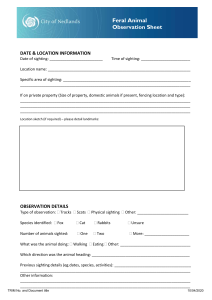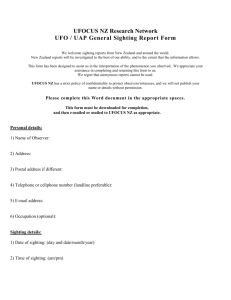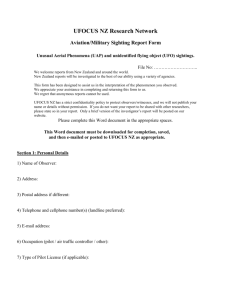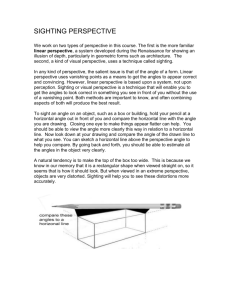.' ·
advertisement
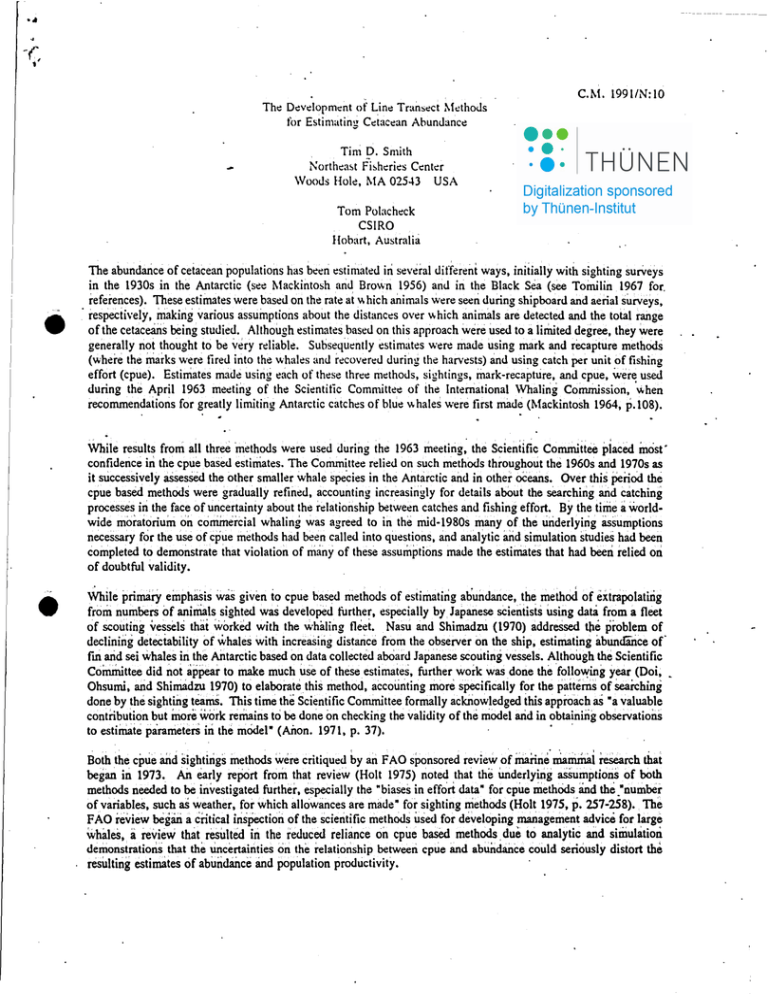
·.. .' -( C.M. 19911N:1O The Devdopm.:nt ot' Line Trans.:ct }'1t:thoJs for Estim'lting Cciaccan AhunJance Tim D. Smith Ccnkr WooJs Holtl, MA 02543 USA l':orthca~t fi~hcrics Tom Po14lehcek CSIRO Hohart, Australia ... • The abundariee of eetaeean populations has bccn cstimatcJ in several Jiffereni ways, inilially with sighting sUrVeys in the 1930s in the Antaretic (sec Maekintosh ariJ Brown 1956) aml in the B1aek Sea (see Tonulin 1967 for, referenees). These estimates were basel! on the rate at .... hieh animals wcre seen during shipboaru and aerial surveys, respectively, making various assumptions about the distanees ovcr .... hieh animals are detected and the total range of the cetaeeans being studied. Although estimates baseJ on this approach were used to a lirruted degree, they were generally not thought to be very rdiable. Subseqi.H::ntly estimates were made using mark anu recapture methods (where the marks were tireJ into the whales .mJ rtleovercJ during the harvests) and using catch per unit of fishing effort (epue). Estimates maue using eaeh of these thn::e methoJs, sightings, mark-recapture, and cpue, wer~ used during the April 1963 meeting of the Scientitic Commillce of the International Whaling comriUssion, \i-hen recommendations for greatly limiting Antaretie catehes of blue .... haies were first made (Mackintosh 1964, p.108). . , . While results from all three 'methods were used ouring the 1963 meeting~ the SeienÜfic Committee piaeed most' confidence in the cpue based estimates. The Committee rdied on such methods throughout the 1960s and 1970s as it successively asses5ed the other smaller whale species in the Antarctic and in other oceans. Over this i>enod the cpue basW methods were gradually refined, aeeounting increasingly for details about the searching and catching processes in the face of uncertainty about the rdationship between catehes and fishing effort. By the time a worIdwide moratorium on cOmlnereial whaling was agreed to in the mid-1980s many of the underlyirig ässumptions necessary for the use of C!,ue methods had been called into questions, and analytic arid simulation studies had been completed to demonstrate that violation of many of these assumptions made the estimates that had been relied on of doubtful validity. While primarY emphasis was given to cpue based methods of estimatirig abundariee, the method of extrapolatirig from numbers of animals sighted was developed further. especially by Japanese scielltists using dab from a fleet of scouting vesseis thäi worked with the whilling fleet. Nasu and Shimadzu (1970) addreSsW problem of declining detectability of whales with inereasirig distance from the observer on the ship, estimating abundäiice of fm arid sei whales in the Aittaretic based on data collected abOaru Japanese scouting vessels. Although the Scientific Coinmittee did not appear to make much use of theseestimates, further work was done thefollo~~g year (Doi•. Ohsumi, arid Shimadzu 1970) to elaboratethis method, accoiinting more specifically for the patterns of Searching done by the sightißg teamS. This time the Scientific Commillee formally ackßowledged tbis approach aS "a valuable contnbuiion but more work remains to be dane on checking the validity of the model arid in obtainiiig observations to estimate parameters in the mOdel" (Ailon. 1971, p. 37). . ' the Both the cpue and sightings methods were critiqued by an FAO sponsored review of manne' ~mmai research that began in 1973. An early report fromthat review (Holt 1975) noted that the imderIying aSSumptions of both methods needed to be investigated further, especially the "biases in effort data" forcpue methOds and the :number ofvariables, such aS weather, for which allowances are made" for sighting methods (Holt 1975, p. 257-258). The FAO review a cntical insPection of the scientific methods used for developing management advice for large whaleS, ä. review that resulted in the ieduced reliance on cpue based methods, due to analytic and simulation demonstrations that Uncertainties on thc relationship between cpue and abuiulance could seriously distort the resulting estimates of abundaOce lind population productivity. begm the The FAO review had also raised many questions ahout sighting based estimates of abundance, but these did not initially receive as much attention within the IWC. Outside that forum, the need for estimates of abul'llhnce of populations of several spedes of dolphins killed incidentally in the eastem tropical Pacific yellowfin tuna purse seine fishery prom'(>too aerial and shipboard sighting surveys based on a method develoPeU in terrestriailna1l'Ull3.1 studies calloo line transect surveys. Conceptually similar to the mdhods devdoped by the Japariese, the terrestrial line . transect mdhods were developed for animals such as grouse. The act of sighting was due, in that case,. to the animal flushing at the approach of the observer. The behavior of the animal was so noticeable that the results of survey did not depend on the observer's abilities. The m,lthematical methods were appliOO to both aerial and shipboard research vessd surveys (see Smith 1981) and to sightings data collected aboard commercial tuna fishing vessels when they Were searching for dolphin schools associated with tuna (Smith 1975, 1981), but the underlying mechanisms of observer searching rather than animal tlushirig was not attendoo to. These methods were adaptOO also for surveys of bottlenose dolphin populations in Florida, where estimates of absolute abundance were also requirOO for management of the live capture tishery (see Leatherwood et al 1978). and were sOon appliOO rather widely to cetaceans. . a Facing the increasing concem with cpile based methods. the IWC sponsorOO a workshop on the design of sighting surveys in 1980, during which results from several major ongoing sighting survey programs were discussed and the appropriate rnathernatical models to use were discussoo. In addition to scientists familiarwith manne ffiamziial studies. experts in surveys for terrestrial animals ,md in ,It-sea search procooures used in military operations . participatOO. Two basic analytic approaches were considered. One was that developed by Japanese scientists and • related approaches in at-sell search procedures ""here the factors considered included: many biological arid behavioural aspects of both the whale (diving time. biowing time) arid lhe observer (angular velocity of eye scanning. physiological discrimination). as weIl as characteristics of the viewing platform (speed. mast height, sighting range) (Aßon. 1982. p. 535). The second was described during the meeting as the "descriptive statistics" approach (Koopmali. 1982. p. 543). who argUed against the approach, noting that statistical curve-fiüing may give a cöridensed representation of b6dies of past observations, but they are too often made under heterogeneous varieties of conditions. usually too complicated io be stated in sufficient detail to seNe as a basis for logical conclusions (Koopman 1982, p. 544). The workshop recommended that the "curve-fitting" approaches were likely sUfricient. but ootOO that further stucÜes Oll many of the underlying factors involved in visual search and animal behavior needed to be looked into. The deveiopment and application of line transect sighting surveys coritinued apace throughout the 1980s both withiIi the IWC and elsewhere. with further inethOdological studies being conducted. primarily within the International Oecäde of Cetacean ReSearch program sp()Osored by IWC. Many new analytic methods were develol>ed. Söme of which accountOO better for the behavior of the animals and had better statistical properties. and many expenmental testS were conduetOO to deternune the effects of factors such as visibility and height of the observerS. the _Reports of the International Whaling Colnmission during the late 1980s for details. See The gradual replacement of cpue-based assessment methods by, sighing sUrVey based methe>ds of Population esiimation and assessment continued within the IWC through the 1980s. In Oecember of 1990 duririg a meeting of a sub-eommittee on developing revisOO management procedures all participants agreed thai cpuebllsed methods would not t>e nirthec considered in any new management procedure that might be developed. Indeed. it was agfeed thai the behavior of the new management procedures under development was satisfactor)r when oDly catch lind sighting surVey data were useu. beeri identified But isthis realty true'? During the deveiopmeni of sighting sUrVeys since 1969 many fadors have as potentiallY affecting the reliability of the resulting population estimates. A complete listwoilld t>e very lang. and while of these factors have been addressed, many have not. What is increasingly being observed during these surveys is that the results vary. with different observers and platforms. and that methodS appropriate to one si>ecies are often not appropriate to another. even though most surveys encounter a miinber of speeies. Same e f ........ .•• :-.... ·1 .. The fol.lowing is a partial list of the outstaiuling issues: 1. reaction of aniffials to the vessel: 2. the fraction of animals which were directly ahead of the vessd which were seen; 3. the effect of mndom movements, especia~ly if the likelihbod· of sighting differs with direction of movement; . 4. the effect of pooling sighting results obtained under heterogeneous sighting conditions, where detectability may vary; 5. methods of measuring distance to sighted animals; 6. methOds of estimating the variances of density estimates 7. the effect of pooling sighting results across observers with different abilities. We can anticipate that as the concern over the effects of whaling arid by-catch of cetaceäns continues the now accepted sighting sur:veys will come under increasing scrutiny. At present the management proceuures being explored within the IWC rely on having estimates of abundance from sighting surveys that are not upwardly bi:lsed, and on having estimates of the sampling variability of these estimates. To erisure that these management scbemes are useful, it will be necessary to remove the sources of downward biases and to ensure that robust estimates of sampling variability are available. This will require further experimental arid theoretical examination of themany of the factörs listed above. By having survey methods which produce estimates which are as nearly unbiased as possible and which proPerly account for the many sources of uncertainty, the new management regimes that are being explorCd will be more likely to be accepted. Literature Cited What. Co_. 22: 34-39... Anon. 1971. Rej>ort of the. Special Meeting on Antarctic Fin Whale Stock Assessment. Rpt. int. ADon. 1982. p.535. Report of the workshop on the design of sighting surveys. Rpts. int. Whal. Commn. 32: 533-549. Doi, T., S. ObSumi, and Y. Shim3rlzu. 1971. Re-evaluation of population stlidies by sigbting obserVations of wh3les. Working paper F/6, Spee. Meeting on Antarctic Fin Whale Stock Assessment, illt. Whaling COmmD.; cambndge, ,England. . . .. ' ..'. Holt, S.J. 1975. Activities ofthe FAO/ACMRR working party on marine mammals. Rpts. irit. Whal. Commn. 25: 253-260. Koopman, B.O. 1982. Comments on the appropriateness ofthe 'descriptive statistics' approach. Rpts. int. Wbal. Commn. 32: 543-544. . .. . LeatherwoOd, S., J.R. Gilbtlrt, and D.G. Chapman. 1978. An evaluation of some techßiques for aerial census of bottlenose dolphins. J. Wildl. Manage. .42:239-2S0. . ~ckintosh, N.A. and S. Brown. 1956. Norw. Whaling Gazette. . . '" .kintosh, N.A. 1964. Meeting of Sub-committee of the Scientific CoriUnittee. Rpt. int. Whal. Commn. 14:io7-111. NaSu, 1, and Y. Shiinaclz11. 1970. A methodof estirnating whale population by sightirig observation. Work.Ü1g Scientific Coinmittee meeting, June 1969, Int. Whal. Comrnn., Cambridge, England. '. . Smith, T.D. 1975•. EstimateS of sizes of tWo populations of pofj>oise (Srenella) in tbe eastem tropical Pacific , .Southwest Fisberies Center, Adm. Rep. U-75-67, LaJolla, Calif. 57 pp. Smith, T.D. 1981. Lme transect tecbniqueS for estimating density of porP6ise scbools. J. Wildl. Manage. 45(3):650-657. Tomilin, A.G. 1967. Mammals of the USSR and adjacent countries. Vol. 9. Cetacea. Jerusalem, Israel Program for Sei. TranSl. IPST (1124): 742 pp. paper, ecean. '0

